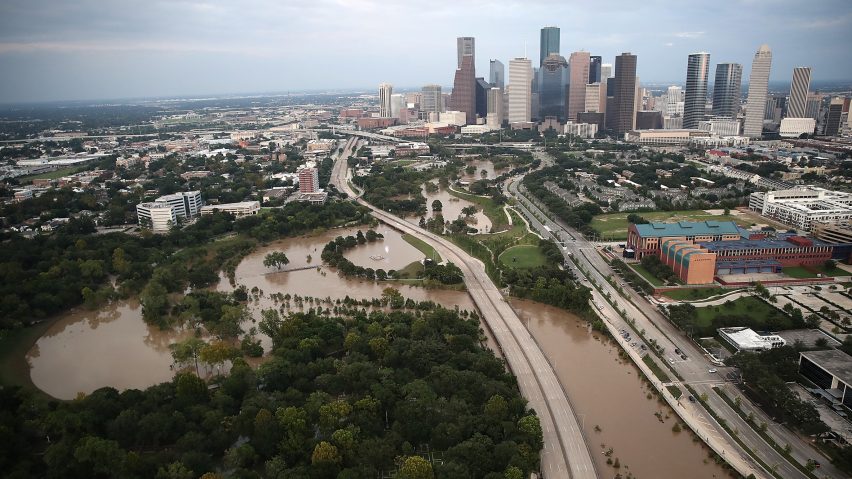
"Urban design caused the Hurricane Harvey disaster"
Houston's poor urban planning, not climate change, is to blame for the catastrophic flooding following Hurricane Harvey, says disaster expert Ilan Kelman in this Opinion column.
Hurricane Harvey was a major storm with extensive rainfall. It was not a natural disaster. The disaster was caused by human decisions to live in a hurricane zone without taking measures.
From a planning and design perspective, so much could have been achieved in the years and decades before the storm loomed on the horizon. The first rule is: if you prefer to stay dry, then do not build in a floodplain.
This can be difficult. Every location has hazards, so it is impossible to avoid the threat of damage. Instead, it is important balance the hazards while designing and building for them.
It starts with siting, land use, and zoning. These have long been lax around Houston. Fuelled by the oil economy, the city expanded without much thought to the consequences. Many others deliberately sought out beautiful coastal locations.
Yet so much can be done to build in floodplains without creating a flood disaster. Permeable surfaces could be used for roads and parking lots. The water then soaks through to the ground rather than immediately running off to the low points.
If you prefer to stay dry, then do not build in a floodplain
Consider designing into a city cheap, reliable, frequent, and safe public transportation. Then, we would need fewer huge parking lots and multi-lane roads, which cover greenery.
Planning for runoff means increasing green space. Streets and buildings can be oriented to direct surface water into designated low-lying areas. These could be ravines used for biking and walking rather than living, parks which become temporary reservoirs, and ponds or lakes which otherwise serve as boating and picnicking areas.
Some trees species soak up water, but care is needed because during droughts, they might die or suck up essential groundwater. Plus, introducing non-native species can severely damage the local ecosystem. Greenways and storage locations have a maximum amount of water they can retain. Any human intervention always has limits and drawbacks.
Hurricane Harvey's flooding in Houston is being labelled as the 1-in-a-1,000 year event. Should we really design for such an extreme? The Netherlands states that they protect their coastlines to the 1-in-10,000 year storm surge. Irrespective of data and calculation limits, we can try if we wish to put in the investment required.
Once this form of wider community planning and design has been decided and completed, then individual structures can make a further difference for living in floodable locations. Building codes, as with planning regulations, must be promulgated, monitored, and enforced. Leaving it up to individual developers and owners frequently yields little result.
Climate change did not create the urban design and social structures that caused the disaster
Dwellings could be raised above ground level. Then, accessibility is important for people with mobility impairments and the building must still be constructed to get wet and to withstand scouring and debris impact during a flood.
Should basements be included to take in any initial floodwater or should they avoided so that people are not trapped in them? Would people buy a house where the ground floor is used only for garages or storage, so that flooding up to one floor does not make the place uninhabitable? What about flooding beyond the ground floor and bungalows?
Materials and finishes can be selected so they are easy to dry out and to clean. Yet floodwater can be contaminated with chemicals and toxins that are not easy to purge. Electrics and plumbing can be raised to avoid replacing them after a small amount of floodwater. Limits exist to how high they can be raised and floodwater might nonetheless exceed their level.
At some point, evacuation becomes the best option. Transport systems can be designed for it, but practice and preparation are essential. As Hurricane Rita barrelled towards Texas in 2005, people were stuck in their vehicles for hours while trying to leave. Dozens died. Had those roads flooded, hundreds would have perished.
Many people do not have the money to evacuate. Public transportation is often inadequate. You must have a private vehicle, take time off work, and pay for gas and alternative accommodation. Insurance helps, but not everyone can afford it. Would undocumented migrants want to evacuate or purchase insurance for fear of being caught and deported?
Living with hurricanes is not just about design and planning
Living with hurricanes is not just about design and planning. It is also about public services and providing knowledge and opportunities to everyone, irrespective of their background. It is taking responsibility for disasters, not blaming the environment or the weather.
Climate change likely affected Hurricane Harvey. Climate change did not create the urban design and social structures that caused the disaster.
Climate change did not avoid planning regulations. Climate change did not cause Houston's population to expand by 40 per cent since 1990. Climate change did not build a chemical factory in a flood zone after politicians lobbied for a delay in safety rules.
No matter what climate change did to the hurricane, a major disaster would have happened. Not from the rainfall or floods, but from the unnatural vulnerabilities and choices which created them. Rather than blaming a natural disaster, we can make individual and collective decisions to live in a hurricane zone without forcing a human-caused hurricane disaster.